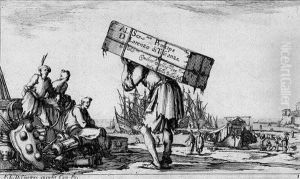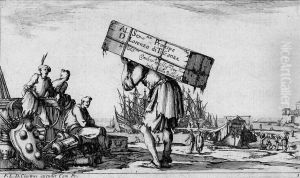Francois Collignon Paintings
François Collignon was a notable French artist and engraver, born in Nancy in 1610 and passed away in 1687. He was a prominent figure in the 17th century, especially known for his mastery in engraving and etching. Collignon's career flourished in a period marked by significant artistic developments in Europe, particularly in France and Italy, where he spent a considerable part of his professional life.
Collignon's early life in Nancy provided him with a rich cultural and artistic foundation, but it was in Italy where he truly honed his craft. He moved to Rome, a hub for artists during the Baroque period, where he was deeply influenced by the dynamism and grandeur of Italian art. In Rome, Collignon became associated with major artists and patrons, which significantly shaped his artistic style and direction. His work often depicted landscapes, historical scenes, and religious subjects, showcasing his versatility and adeptness in capturing intricate details and emotions.
Throughout his career, François Collignon was known for his exceptional skill in the art of engraving, which involves incising a design onto a hard surface by cutting grooves into it. This technique allowed for the mass production of images and played a crucial role in the dissemination of artistic and cultural ideas across Europe. Collignon's engravings were highly sought after by collectors and connoisseurs, contributing to his reputation as a master engraver.
Beyond his technical prowess, Collignon also played a significant role in the artistic community as a mentor and influencer. He was involved in the training of other artists, passing on his knowledge and skills to a new generation of engravers. His contributions to the art of engraving and his influence on the artistic practices of his time have secured his place in art history as a key figure in the evolution of printmaking.
François Collignon's legacy is preserved through his extensive body of work, which continues to be studied and admired for its artistic merit and historical significance. His engravings not only provide insight into the artistic trends and cultural contexts of the 17th century but also showcase the enduring beauty and complexity of this form of artistic expression.

